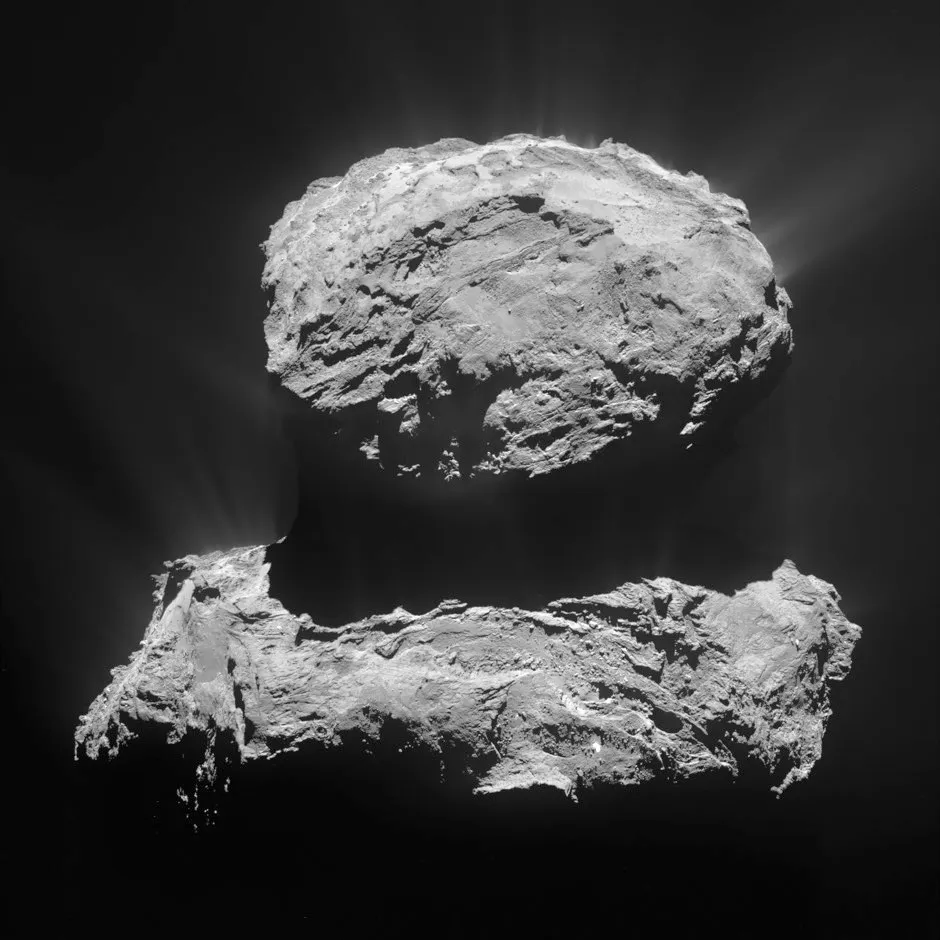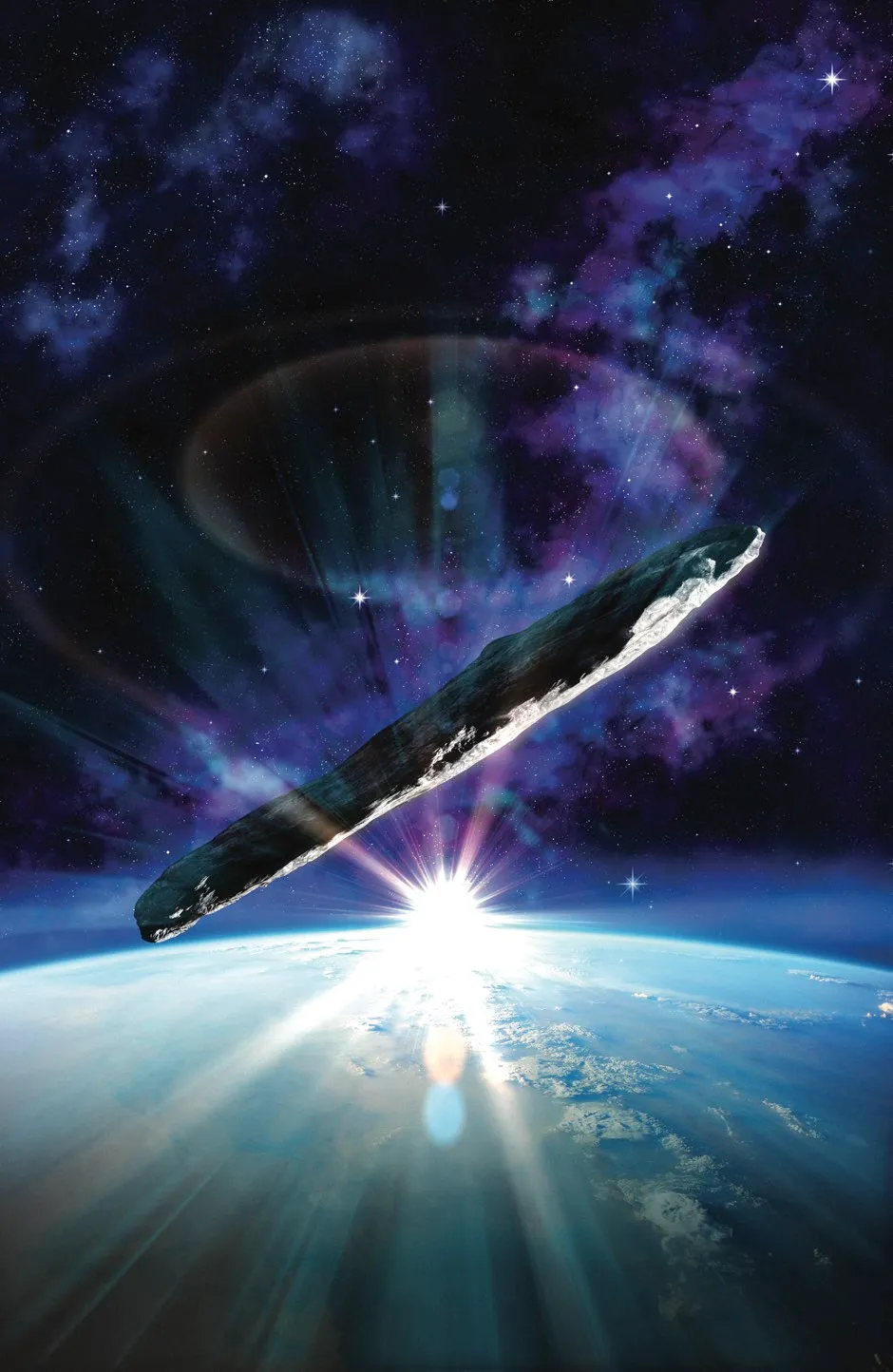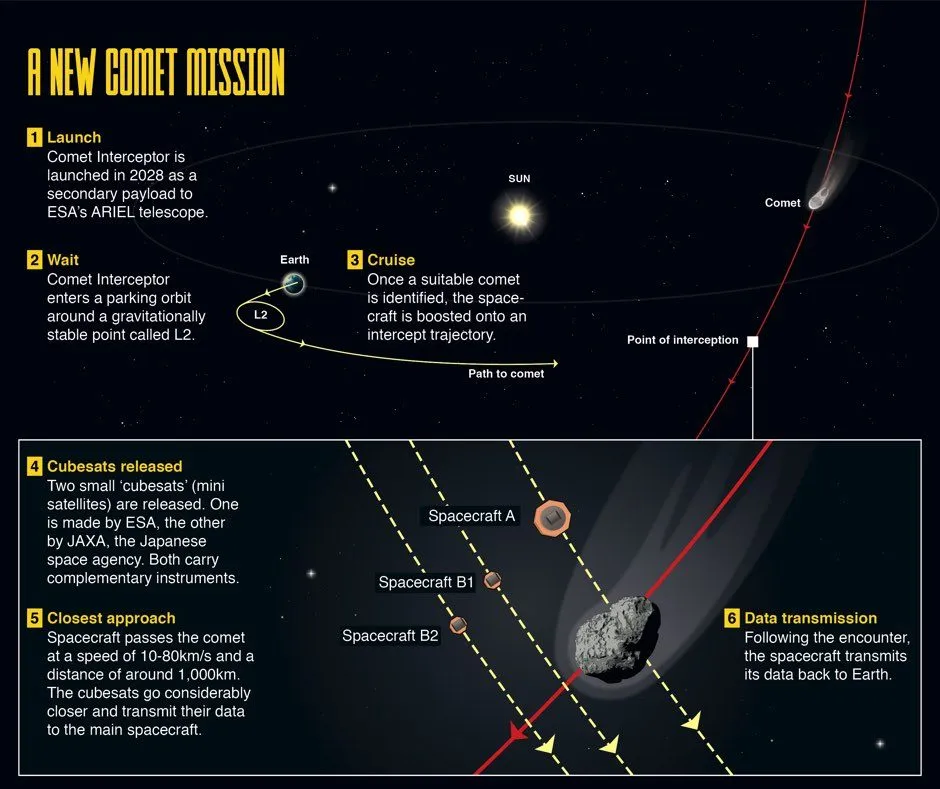We’ve come a long way since thinking that comets were ghostly apparitions in the sky that foretold disaster and disease. Now we understand that these mysterious celestial objects are time capsules to an earlier era in the history of the Solar System.
They can tell us about the days when the planets were forming. Comets can also reveal some of the chemical constituents that would have been present on the early Earth and so could have contributed to the origin of life.
It’s therefore no surprise that the various space agencies around the world are keen to explore comets with spacecraft. Currently under development is Comet Interceptor, which is due for launch in 2028 and will allow us to inspect these icy bodies in greater detail. But it’s by no means the first mission to visit a comet.
In 1986, Europe, the USSR and Japan launched missions to fly past Halley’s Comet. Of these, the spacecraft that drew the closest was the Giotto mission, from the European SpaceAgency (ESA). It gave us the first image of a comet’s icy nucleus and showed that gas was shooting into space from jets on the surface.
Read more about comets:
- Five things you (probably) didn't know about comets and asteroids
- Who really discovered Halley's Comet?
ESA’s more recent comet mission, Rosetta, rendezvoused with the comet 67P/Churyumov-Gerasimenko, and followed it for two years between 2014 and 2016. It revealed unprecedented information about how a comet behaves as it draws close to the Sun, and then heads into deep space again.
One thing became very clear. “There are a lot of evolutionary processes taking place on the surface layers of a comet. The surface actually changed as we were watching with Rosetta,” says Dr Colin Snodgrass, an astronomer from the University of Edinburgh who was part of the Rosetta team.
They watched as areas were eroded away, while others were buried in material falling back to the surface. “We always knew that comets eroded but the extent to which they changed each time they passed the Sun was something that we really learned from Rosetta,” says Snodgrass.
A mission like no other
That’s both good and bad news for astronomers. While it means that we know more about how a comet works than ever before, it also tells us that their surfaces are not a pristine record of the original planetary building blocks. All of the comets we have visited so far are called short-period comets.
They are ancient objects that formed in the outer reaches of the Solar System, beyond the giant planets, and have since fallen into closer orbits around the Sun. Here they have been periodically sunblasted and altered, perhaps beyond recognition from their original states.
Read more about the Rosetta mission:
- The great debate about whether Rosetta rock 67P is breaking apart
- Rosetta's lander Philae has been found – here's why it's important
Thankfully, for helping us understand how the planets formed, there is another class called the long-period comets. These are on gigantic orbits. In 1997, comet Hale-Bopp appeared in our skies and was visible to the naked eye for 18 months. Based on its current orbit, it may have last been close to Earth around 4,200 years ago.
A year before, in 1996, comet Hyakutake passed by on an orbit that will take around 70,000 years to complete. All of these comets have surfaces that must be much closer to their pristine states.
No-one has ever designed a mission without a first idea of what the target is. This is very uncharted territory
Colin Snodgrass
There is also the occasional comet that falls back towards the Sun for the first time. These are the ones we really need to look at if we are going to unlock the secrets of the early Solar System.
As well as being pristine, astronomers think that they originally formed between the giant planets, making them much more representative of the actual building blocks that made up the planets in the first place. Gravitational interactions with the newly formed planets then threw them out to vast distances, where the intense cold has preserved them.
If we could see one up close, it would be an opportunity to examine a completely different region of the early Solar System. But we never know when they are coming, and spacecraft take the best part of a decade to design and build, by which time the comet has been and gone. So, how will we ever get to see one up close?
That’s where Comet Interceptor comes in. ESA has given Snodgrass the funding, and he and Prof Geraint Jones from University College London will mastermind the mission. Comet Interceptor will launch in 2028 and will wait in space until a target comet is found.
Designing and planning the mission will be unique, however, as there isn’t a specific comet in mind. “No one has ever designed a mission without a first idea of what the target is. This is very uncharted territory,” says Snodgrass.
A space mission usually has a specific target, and that allows engineers to calculate the optimum trajectory, and therefore how much fuel will be needed, which tells them the size of the fuel tanks, which tells them how much mass is available to use for the scientific instruments. In other words, the target defines the spacecraft.
The proposed encounter also allows the design team to figure out the optimum place to put the solar panels and the instruments. None of these things are known for Comet Interceptor. The team does not know what direction they will approach their target from, how far from the Sun the comet will be, or how far from the Earth. So they have to design an extremely flexible mission.
The mystery of planet formation
Comet Interceptor will take images of its comet’s surface at comparable quality to those that Rosetta took of comet 67P, and it will look at the differences in composition between the two comets. “We expect the chemical makeup of such comets to be potentially very different from 67P-like comets,” says Prof Stephen Lowry, a comet expert from the University of Kent.
This is because they formed closer to the Sun, meaning that the warmer environment would affect the number and type of organic molecules on their surfaces.
There is a universe of organic compounds that need to be identified
Gianrico Filacchione
It’s not only chemistry that could be different, as the long-period comets could also reveal whether the planets formed violently or gently. “One of the top five results from Rosetta was the shape of the comet,” says Lowry.
Comet 67P was a dumbbell-shaped object that analysis showed was the result of a fusion between two independently formed comets. It was a big result because it showed that fully formed comets were merging in a gentle way; their collision speed must have been around walking pace.
Yet, it was thought that planet formation took place much more violently. If the pattern repeats in a long-period comet, it could well mean that our ideas of planet formation as a whole need to be revised.

The search for the mission’s target begins in 2022, when a bold new telescope project starts its operations. The Large Synoptic Survey Telescope (LSST) is currently under construction in Chile. With its eight-metre-wide mirror, LSST will be able to scan the whole sky every few nights.
It is expected to discover hundreds and thousands more comets and asteroids in the Solar System than are currently known to exist. It could even find a target before Comet Interceptor’s scheduled launch in 2028.
“We don’t actually expect there to be that big a choice of target. Within the period that the mission has to operate, probably there is only going to be a handful that we can go to,” says Snodgrass.
Read more about exploring our Solar System:
- Messages from the edge of the Solar System: What New Horizons is still revealing about Pluto and beyond
- Planet Nine: How we’ll find the Solar System's missing planet
- Farout: 'We discovered the most distant object ever observed in our Solar System'
Out of that handful, there is also the possibility that they will find something truly rare: a comet from another solar system entirely. Astronomers have identified two such interstellar objects, starting with ‘Oumuamua in 2017 and Borisov in 2018.
Both of these objects followed trajectories that indicate that they are not bound to the Sun’s gravity, and must simply be passing through the Solar System, being deflected by the Sun’s gravity en route.
To actually see something that's come from another system... It would be such an opportunity that you couldn't really turn it down
Colin Snodgrass
Although it would be almost impossible to say which star they formed around, looking at a comet close up would be a fascinating way to tell if formation processes around other stars are similar to those that took place in our Solar System.
“To actually see something that’s come from another system and see how different it looks, or how similar it looks would be interesting,” says Snodgrass, “If there is one we can reach, I think it would be a fairly easy decision from the science team to say, ‘let’s go for that’. It would be such an opportunity that you couldn’t really turn it down.”
Interstellar visitors
In 2017, astronomers identified a comet from a completely different solar system passing through our own. Discovered by the Pan-STARRS telescope at Haleakala Observatory, Hawaii, it was called ‘Oumuamua, the Hawaiian word for ‘scout’. At first, it looked like an asteroid because it did not display tails like a comet, nor a surrounding gas cloud known as a coma.
But later, it began to accelerate in a way that could not be described by the gravitational pull of the Sun or the planets. Although this led to some lurid headlines about it being an alien spacecraft, such behaviour is precisely what comets do. It occurs because the heat from the Sun releases gas from the ices below the comet’s surface, and the escaping gas acts like a small rocket motor.

In 2018, another interstellar comet was identified cruising through the Solar System. Called Borisov, it made its closest pass to the Sun in December 2019 and was estimated to be losing two kilograms of dust and 60 kilograms of water every second.
Read more about 'Oumuamua:
The idea of using Comet Intercepter to see something from another solar system is clearly tantalising for the science team, but they are also realistic about their chances of actually targeting one.
“It’s a pretty remote chance to be quite honest,” says Snodgrass. This is because we have no idea how frequently they pass by. It may simply be blind luck that we have identified two in as many years. Astronomers will know more when LSST begins work in 2022.
Unlocking the secret to life on Earth
No matter which target Comet Interceptor goes to, astronomers are already planning what to do after that. And for them, the driving question is what role comets played in the origin of life on Earth, and that comes down to doing an inventory of its surface chemistry.
In particular, astronomers look for carbon-bearing molecules, often referred to as ‘organic molecules’ because they have become essential for life on Earth. “The composition of the organic material is really important,” says Gianrico Filacchione, a comet scientist from the Institute for Space Astrophysics and Planetology (INAF-IAPS) in Rome, Italy.

“There is a universe of organic compounds that need to be identified,” Filacchione says. And the only way to do that definitively is to bring a sample back to Earth and analyse it with the full force of current laboratory equipment.
To that end, Filacchione and colleagues have proposed the AMBITION mission to ESA as part of the space agency’s 2050 long-term plan. If selected for development, AMBITION would land on a comet, scoop up a sample of the icy material and return it to Earth in a cryogenic capsule. “Taking a piece of a comet back to Earth is the holy grail for a cometary mission,” says Filacchione.
For now, however, it is Comet Interceptor that is in the limelight. “This is an opportunity for us to go and see a comet that’s coming into the Solar System for the very first time. The surface will still be looking as it has been over billions of years,” says Snodgrass.
But to see it requires rewriting the way space missions are designed and planned. While that will bring its own headaches, Snodgrass says he finds it more exciting than it is daunting. Although, he then adds with a touch of humour, “that’s because I’m not an engineer and I don’t have to make it work.’’

